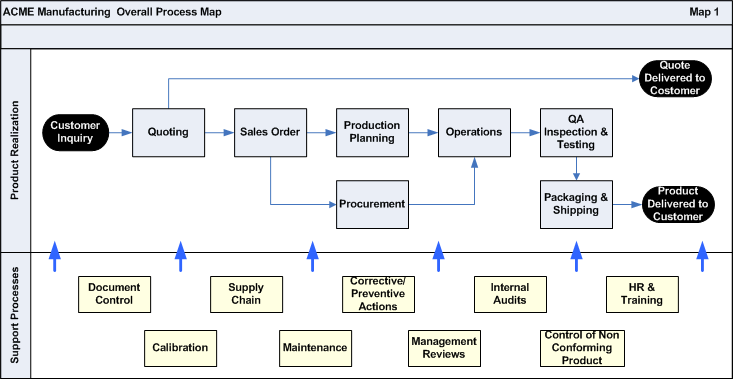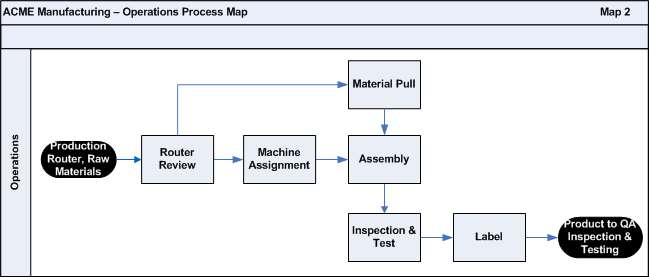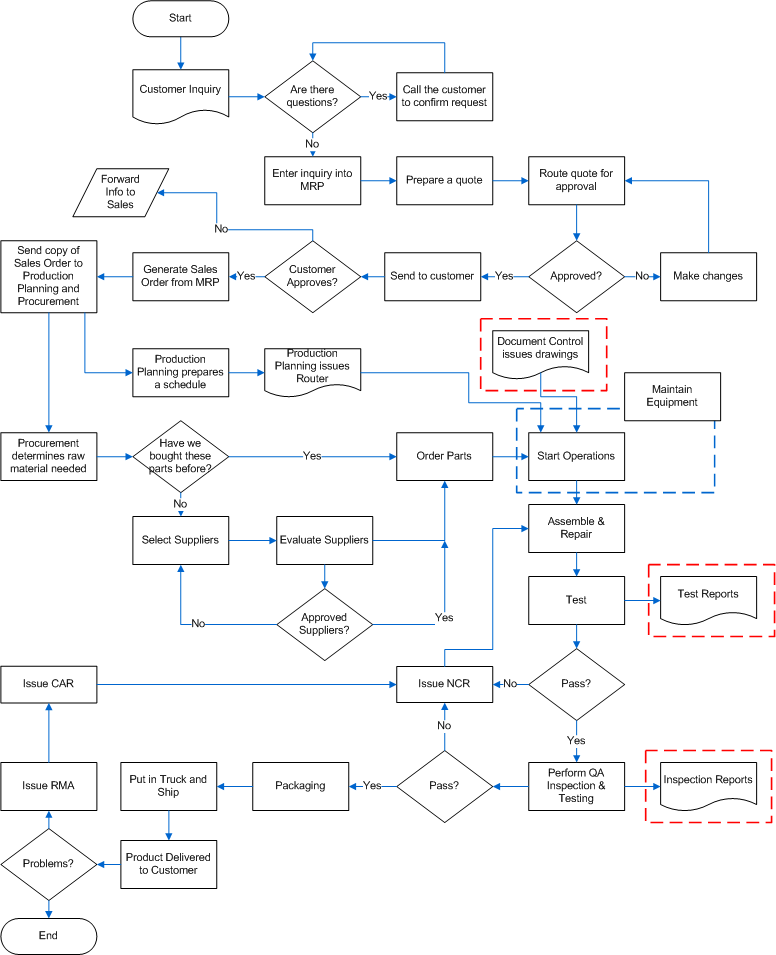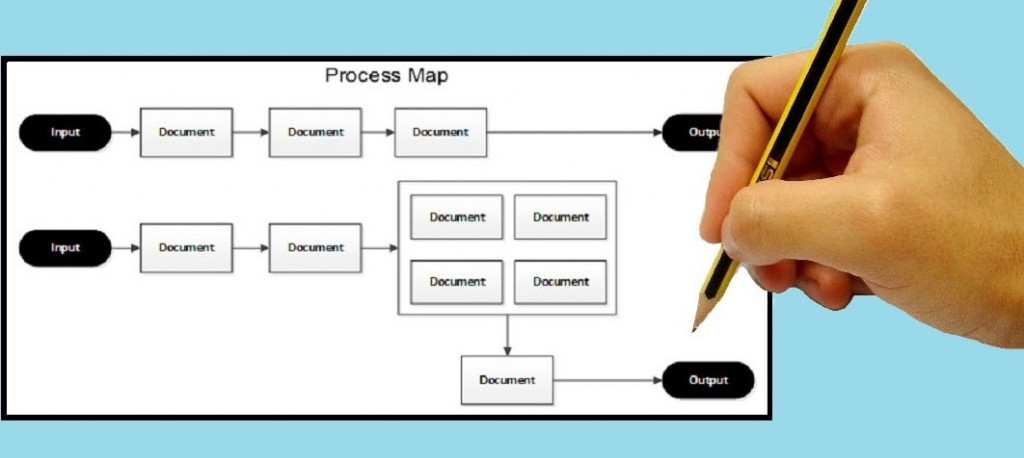What is Process Mapping
Process mapping is an essential technique for identifying all the processes that take place in an organization as well as their interrelation so that it is easy to understand the sequence at which these processes take place. A good process map should be a high-level map of how your organization processes flow, showing inputs and outputs and how your production or service goes from being input through each of the processes until it becomes the desired output. Each process on the process map should coincide with a process actually taken place in your organization, and be called and defined in the same way your organizations call it; not the way your neighbor calls it, or the way somebody called it at their previous organization. This is the defining moment that makes an organization unique, is the process mapping: even if two organizations make the same product, and perhaps have similar processes, their process maps will not look the same.
Qualities of a Good Process Map
As mentioned earlier, a good process map is simple yet effective at portraying the sequence or interactions of a process. A good process map encompasses a lot, yet is very easy to understand and follow. Below are some of the main components present in a good process map:
- Inputs
- Core processes
- Interactions shown by arrows
- Outputs
- Support processes
A good process map that is a sub-process of another map, will also ensure that inputs match the outputs of the parent map and that outputs match the inputs of the subsequent process map.
Below is an example of an organization’s main process map (Map 1) and the process map of one of the sub-processes (Map 2):

As we see on Map 1, the Processes at this organization start with a customer inquiry. Once that is received, it triggers the quoting department to perform quoting functions. Notice that in this case a decision box is not placed, because quoting is not a step, but rather a process step, which contains in itself multiple processes.
Once the quoting process is over, notice that there are two outputs here, one of the outputs is a quote to the customer and the other -if the quote is accepted-is the actual quote to the Sales department for Sales Order processing.
Outputs from the Sales Order process are mainly a Sales Order to Production Planning as well as Procurement. On the Procurement side, once that process is complete, the outputs feed into the Operations Departments. Likewise, the Production Planning outputs feed into the Operations Department.
Finally, Operations feed into QA, and then the product is packed and shipped until finally, the product arrives at the customer.
You can also see in yellow boxes, all the support processes taken place in this organization. These support processes interact at any stage with the product realization processes. Therefore to avoid confusion, they are placed separately but with blue arrows showing their contribution.

On Map 2 we see the detail process map of the Operations Process depicted on Map 1.
As mentioned earlier and as seen on Map 1, the Operations Process has 2 inputs, one coming from Production Planning – Router- and one coming from Procurement-Raw Materials. Once inputs are received, they are reviewed in the Router Review process, and then sent to the Machine Assignment Process as well as to Material Pull. Once the material is pulled, then it goes to Assembly, Inspection & Test, and finally to the Label process. At the end of these processes, the output – which is the approved product by Operations, goes to the next step called QA Inspection and Test.
Without a doubt, anybody would agree that these two charts can paint the picture of what goes on very well.
Where the Real Value Is
Take a look at the Process Map on Map 1. What if I would tell you that the procedures that your company needs are represented by the processes identified in this chart. Voila! Bingo! This process map is the key to identifying the processes that need to be formalized in your organization, by way of procedures.
Once you know what procedures you need, more than likely you can concentrate on developing those and making them robust. Of course, many more procedures or work instructions may be needed to sustain your processes, but at least now you may be able to segregate by affinity each of the main core processes on the core Product Realization Process Map.
Misconception and Misuses of a Process Map
With sophisticated software programs able to give you multiple icons and fancy graphics, it’s easy to misuse a process map and go overboard by incorporating all the neat figurines available. While that may make the process map pretty, it is basically not functional. One of the main misconceptions of a process map is that it is mistaken for a flowchart. While they are very similar and people often use both terms interchangeable including myself, in my view and for the purposes of the organization’s improvement sake, they are different. Below are some of the main differences between a flowchart and a process map:
| Process Map | Flowchart |
|
Start with inputs, which may be more than one
|
Start with a single start block
|
|
Identify individual process of a larger process
|
Identify each step of a process
|
|
Has very few decisions boxes as decisions may be happening within each of the processes
|
Has many decision boxes as they occurred
throughout
|
|
Ends with outputs
|
Ends with an end block(s)
|
|
May be part of a procedure
|
Is usually a procedure on its own
|
|
Help paint a high-level picture
|
Help paint a detailed picture of instructions
|
Below is a really good example of the ACME’s Overall Process Map as seen in Map 1, but this time is shown as a flowchart.

With a flowchart like that, it will be hard to understand what really goes on at the company. What are the core business processes or what starts first or where everything ends. A flowchart like that does not add value to the company and does not lend itself to any kind of employee ownership to a process. That is why we have the whole section called Support Process and the arrows shown indicate that these processes interact with all the processes in the core business area -at any given time. If you really think about it, you could not say the NCR process only shows up when a product is rejected at QA, could you? An NCR can happen during receipt of materials, procurement, operations, QA, shipping, etc. and therefore could trigger the NCR process anytime during the product realization cycle.
Where are the Decision Boxes?
A process map should be easy to understand and follow and adding too many variables may not necessarily add value.
One of the main concerns I get when I remapped a company’s processes is “Where are the stop gates, where are the decisions boxes?” While that sounds good in theory and looks pretty on paper, each process is full of decisions, and to try to identify them in a process map would be like trying to create a giant flowchart. You would need a whole wall to try to identify each process, decision, and outcome that may happen throughout the process. Again, a process map should be easy to understand and follow and adding too many variables may not necessarily add value. Of course, when different outcomes are indeed present then the use of multiple inputs should indicate the different paths that may be occurring within the process.
Process Mapping: Where all Procedures Begin and End
Process mapping is and should be a prime step in procedure development. As a consultant, I recommend keeping the following points in mind when conducting a process mapping exercise or when creating a process map:
- Do not confuse a process map with a flowchart. A process map is usually part of a procedure, and therefore don’t need to explain every single detail, because that may be covered in the procedure. While a flowchart usually explains all the details of a process and may be used in lieu of a procedure or work instruction.
- During the process mapping development, involve employees that are part of the process that will be mapped. Although you may think at times that too many heads may prevent things from flowing or from reaching any consensus, actually the opposite will happen –especially if the process mapping exercise is carried out by a competent expert in process mapping with a broad vision, experience, and excellent people skills.
- Do not base your process map on what is desired, but rather what is being done. Basing your process map on steps that nobody is following will create faulty procedures that nobody will adhere to. Wait until you have completed the process map or at least until you have a good picture of what is being done before you introduce some wanted steps. If your processes are not in control, most than likely your own employees will tell you where new steps are needed.
- Don’t worry about spending too much time on process mapping. While one or two sessions should be enough, spending three or four sessions may be necessary if you are dealing with disjointed groups who you are hoping will be joined through new procedures. Creating a procedure in parallel is also suggested, as describing the process in words may actually bring more things to reality and actually shape the process map into place.
- As with any continual improvement exercise, a process map is not set in stone and may be revised many times as new things are discovered or as the procedure is put in place. As mentioned above, if your process mapping session seems to be taking long, creating your procedure is a good way to concretize the process map.
- Ensure the procedure is built around the process map and actually follows it in order to enhance it. While the process map should show a picture of the processes in place, each of those processes should be further explained within the procedure or if the case merits even in its own procedure. For example of good looking procedures, you can email the author at [email protected].
Less is More
If there is a phrase that could best represent a process map, it ought to be “a picture says 1000 words”. A good process map is lean and can tell a whole story in a matter of a few blocks, so don’t make the process map cumbersome enough that employees can’t understand it or follow it. Your process map and your procedure should complement each other. The process map is the big picture and the details can be in the procedure. If you have the need to put the details in the process map, then make it a flowchart and do away with the procedure, so that they don’t contradict each other or furthermore, so that there is no redundancy.
I have seen many process maps in my auditing and consulting career and some of them have a lot to say, literally, to much I can’t even understand. Depending on what hat I’m wearing, I may or may not comment on it and take the process map for what it is. So the fact that you have not received any comments on your process maps does not mean it is perfect. Take a look at your process maps and ask yourself, can I understand them? Can I follow them? If the answer is no, then do you think your employees can?
Sometimes taking a step back will help you take a step forward. Go ahead and remap your processes and see how going to the drawing map board can help your company take a quantum leap into what your organization deserves…World Class Quality.

A slightly revised version of this article was published by ASQ’s Quality Progress magazine in the November 2010 issue.
Advance Your Knowledge with API and ISO Training from Mireaux University
Whether you’re preparing for certification or ready to take your team’s expertise to the next level, Mireaux training gives you the tools to succeed. Through Mireaux University (Mireaux-U) — our dynamic online learning platform — you can access course materials anytime, watch exclusive bonus videos, take your online exam, and download your certificate instantly. Experience expert-led training and real-world insights designed to empower your success. And link Mireaux University to this page:
ISO Training API Training



